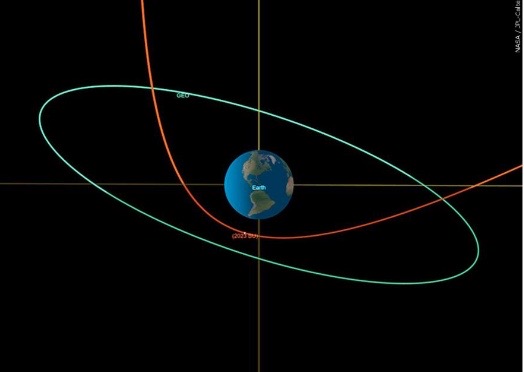A close asteroid to Earth makes an appearance

Asteroid 2023 BU’s trajectory in red, to fly by Earth
February 9, 2023
A relatively small asteroid flew extremely close to Earth on Jan. 26, less than a week after it was first discovered.
The asteroid was discovered on Jan. 21 by astronomer Gennadiy Borisov in Crimea. Five days later, the asteroid passed by Earth, getting as close as 3,600 kilometers from the surface of the Earth near the southern tip of Antarctica, making this one of the closest approaches to Earth ever by an asteroid
The average distance between the Earth and the Moon is around 239,000 miles. Geosynchronous satellites typically orbit 22,000 miles above the surface of the Earth.
This means that the rock was well within the orbit of a lot of valuable satellites. Had the asteroid collided with one of these satellites, the damage would have been very costly. Luckily though, 2023 BU managed to pass through the orbit without hitting anything.
The size of the space rock is estimated to be between 11.5 and 28 feet across. While that is fairly sizable, most of the asteroid would burn up while passing through Earth’s atmosphere, with any larger surviving parts becoming meteorites if it had traveled straight to Earth. Because most objects like this do not, the asteroid did not pose any danger.
The asteroid, like many, was a surprise to scientists when first found. Asteroids have very large eccentricities, meaning their orbit gets to be quite far away from the Earth. When they are far away, they are very dim, making it very difficult for scientists to notice them until they start getting close to Earth.
For space watchers unable to view 2023 BU firsthand, the Virtual Telescope Project broadcast the event on its website and YouTube channel.
Donovan Domingue, an astronomy professor at GC, did not watch the livestream of the event. However, he did have some interesting things to say about the asteroid.
“Asteroids are always breaking apart after some time, and that is what gives us meteor showers,” Domingue said. “We have meteor showers every year when we go through our orbit.”
When asked about what would have happened had the asteroid been of larger size, Domingue had a lot to say.
“Asteroids of any size are going to be quite dangerous if they were to intersect with the Earth,” Domingue said. “At the very least, it would affect our oceans. We do not have any great examples of a comet breaking up into major pieces, so it is not quite something that would happen, unless the asteroid were to be directed at the Earth.”
A lot of people have been wondering if the asteroid did any damage to Earth’s atmosphere when it passed by. However, it did not impact our atmosphere in any way. It was very distant, about midway between the orbit of Earth and Mars at its closest approach, making it too far away to do any damage to our atmosphere.
The asteroid raised fears among people about what would happen if another one were to come in the future. When asked about fears of an asteroid hitting Earth, Domingue had this to say:
“If we were to discover one suddenly, it could be on a collision path with Earth, and in that scenario there is really nothing we can do about it.”
It was fearful for many students to learn about, even though it was not heading directly to Earth.
“I thought that it was a little unsettling, but it was calming to know that it was not coming straight towards Earth,” Brooke Suplee, senior marketing major said.
For those who did not get the chance to see this year’s trip, will have an opportunity to see it in another decade.
“2023 BU orbits the sun every 425 days and will not pass close to our planet again until Dec. 6, 2036,” Brett Tingley said, editor of Space.com.






